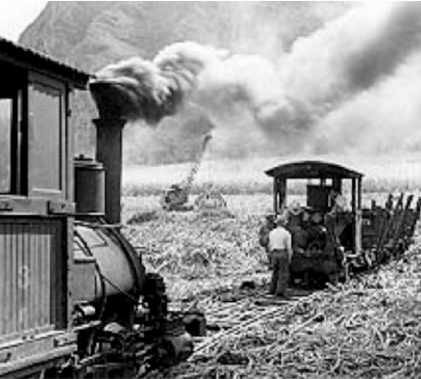In 1877, Mr. Theophilus H. Davies demonstrated his entrepreneurial foresight and his faith in the potential growth of sugar in the Hamakua District by establishing a partnership with Mr. Charles Notley, Sr., to promote sugar production. During the following year, Mr. Notley began planting cane and Mr. Thomas Hughes from the Honolulu Iron Works, commenced building a mill for Mr. Davies.
The Hamakua Mill Company (HMC) concerned itself with milling operations in the area and was incorporated in 1883 with Mr. Hughes as its manager. The factory’s first season was in 1885. Mr. Notley was the manager for the Hamakua Plantation Company whose main objectives were the growing and cultivating of sugarcane. The Theo. H. Davies Company was agent for both sugar interests.
 The Hamakua Mill Company was located at Paauilo on the Hamakua Coast of the Big Island of Hawaii. The plantation encompassed six miles and was three miles across at its widest point. One side of the Company bordered the ocean with a windbreak of ironwood trees and sea cliffs. The other side rose to an elevation of 2000 feet.
The Hamakua Mill Company was located at Paauilo on the Hamakua Coast of the Big Island of Hawaii. The plantation encompassed six miles and was three miles across at its widest point. One side of the Company bordered the ocean with a windbreak of ironwood trees and sea cliffs. The other side rose to an elevation of 2000 feet.
The date of consolidation between Hamakua Mill and the Hamakua Plantation Companies could not be discerned from the records and other sources indicate conflicting dates. However, according to cashbooks LSCv. 108 & 109, it appears that these companies may have merged in September 1899.
By 1910, 4800 acres were planted in cane and nine miles of railroad track and three locomotives with numerous cane cars were used for transporting sugarcane. A warehouse at the boat landing was located on an overhanging cliff which allowed ships to anchor close enough to load sugar bags b crane. Contrasting with a labor population of twenty-nine in 1890, over six hundred people were employed by HMC in 1910. At this time, there was also a company store, a school and several churches in Pauuilo.
By the 1920s, twenty-one contracting gangs supplied the cultivation necessary for growing the cane and HMC employed close to 1200 people. The water supply for both domestic and mill purposes came from either water storage tanks or springs. As typical for plantations on the Hamakua Coast, no irrigation was necessary. When sugarcane was harvested from the fields, it was taken down to the cane cars or railroad by wagon or wire rope slings. Some fields at higher elevation were so difficult to harvest, that a cable and steam hoist system was used to bring the cane down to the railroad. By the 1930s, all cane was delivered to the mill by railway, which consisted of fourteen and a half miles of track and over thirty railroad bridges crossing numerous gulches. Varieties of cane included D-1135, yellow tip and striped tip cane.
Mr. Anthony Lidgate managed the Hamakua Mill Company for the longest period of time, form 1888 (1886?) to 1921. The following men were managers during the time span encompassed by the Archives HMC collection; Robert M. Lindsay, 1921-1933, and William F. Robertson, 1933-1956.
 Kukaiau Plantation became part of the Hamakua Mill Company in 1914. Since its inception, the agent for the Kukaiau Plantation Company was H. Hackfeld and from 1884 to 1912, Messrs. J.M. Horner and Albert Horner were the plantation managers.
Kukaiau Plantation became part of the Hamakua Mill Company in 1914. Since its inception, the agent for the Kukaiau Plantation Company was H. Hackfeld and from 1884 to 1912, Messrs. J.M. Horner and Albert Horner were the plantation managers.
Under the direction of Mr. Davies, the Kukaiau Mill was built and first managed by Mr. George F. Renton, 1888-1899. The Kukaiau Mill and the Kukaiau Plantation appear to have merged in 1914. Subsequent managers for the Mill were; E. Madden, 1900-1911, and J. McLennan, 1912-1918. The Kukaiau Mill ground its last crop in 1917 at which time the mill and the boiling house were sold to the Japanese for use in Formosa.
By 1972, cane from HMC was being ground at Laupahoehoe and in 1974, the Hamakua Mill Company became part of the Laupahoehoe Sugar Company.
Sources
Deborah A. Saito
Susan M. Campbell
www2.hawaii.edu/
